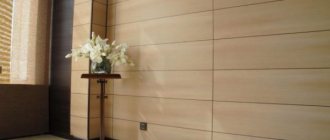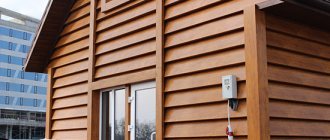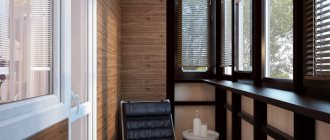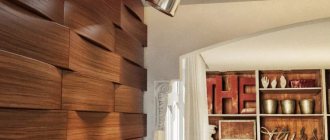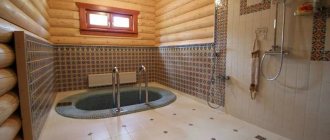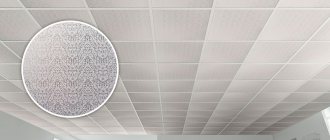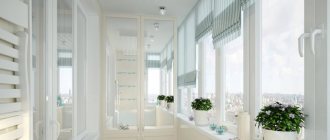Features of production and advantages of MDF
MDF panels are a material consisting of a finely dispersed fraction of wood shavings.
To obtain panels, wood waste is crushed, the resulting fraction undergoes heat treatment, and as a result, an adhesive composition is released - paraffin or lignin. It glues the mass together, and by pressing it gives the necessary strength. Then a melamine film or veneer is glued onto the surface, which gives a beautiful decorative look. Film lamination gives the material an almost indistinguishable resemblance to natural material, while the price remains affordable. The film has different colors and textures, which justifies the widespread use of MDF panels for interior finishing work.
The manufacturing process for MDF is similar to that of particle board. But chipboard contains formaldehyde resins, which are harmful to human health.
In terms of ease of use in the construction industry, chipboard is inferior in reliability of fastening with screws. After some time of use, the holes may become loose and fasteners may fall out. Repairing chips is difficult and sometimes impossible.
MDF boards have a denser structure, which allows them to securely hold fasteners. It is also worth noting the environmental friendliness of MDF. A high-quality board contains only natural substances that are safe to use: wood and carbide resins.
Additional advantages of MDF:
- durability and ability to resist mold and rotting processes;
- water resistance, so the material can be used in rooms with high humidity;
- flexibility when heated, allowing the panel to be slightly curved if necessary.
- maintainability: damaged elements can be easily replaced with new ones without dismantling the entire cladding;
- ease of installation: even beginners in finishing can cope with attaching MDF to a suitable base;
- panels allow you to hide electrical and other communications behind you;
- the material is hygienic and easy to care for: the panels are easy to clean, and if necessary, they can be treated with non-aggressive household products.
The disadvantage of MDF is:
- low resistance to mechanical stress. Although the damage can be easily eliminated by masking it with paint of a suitable color.
Installation methods
Installation of MDF panels for interior wall decoration is carried out:
- for liquid nails (glue) - in this case the surface of the walls must be leveled;
- on a frame made of wooden beams or a metal profile - this option allows installation on uneven surfaces with a large difference; this method is also used if you need to hide communications or additionally insulate the room.
When constructing a frame, the method of fastening depends on the materials used to create it - if it is a metal profile, then self-tapping screws are used, if it is wood, then staples and nails are also suitable.
The frame is used only if there is no risk of fungus developing on the surfaces - the walls are cleared of coating, inspected, high humidity is eliminated, cracks and cracks are sealed, and special treatment is carried out to prevent the development of microorganisms. The surface is primed. If necessary, stick penofol (insulation).
Frame mounting
Before installing the panels, cable routing is carried out and the location for switches/sockets is determined. Holes in the panels for them are cut in advance. Wooden elements are provided for support.
The location of the guides depends on the installation method of the panels - if they are mounted vertically, then the profile (beam) is laid horizontally and vice versa. The guides are attached to the wall level, the step between them is 50-60 cm. Anchors or self-tapping screws are used. In uneven areas, pieces of timber or other material are placed to eliminate the defect. A sheathing is constructed around the perimeter of door and window openings - it is necessary for attaching panels, trims, and slopes.
The strips are cut to length (when taking measurements, take into account the installation method - along or across the wall). Installation starts from the corner. When positioned vertically, the first element is installed level (with the tenon towards the corner) and attached to the guide. The next plank is fixed to the previous one - the ridge is inserted into the groove all the way, and the other side is secured with a clamp (a metal fastener for hidden installation).
The last fragment located on the wall is cut off before reaching the corner (5 mm is left so that the first panel can be fixed on the next plane). After completion of the installation work, all fittings are installed (platbands, baseboards, corners, etc.).
When the planks are horizontal, they are mounted in the direction from the floor to the ceiling.
Installation using glue
To attach the panels to the wall, an adhesive composition is used, which remains plastic for some time after application (from 5 to 15 minutes) - universal or specialized glue is suitable (for wooden products). It is applied to the canvas in large dots or in a wave, wait the time specified by the manufacturer and fix it by level. To securely attach it to the wall, gently tap the panel with a fist or a rubber mallet. Exposed glue residues are wiped off with a damp sponge.
Decorating walls with MDF panels is one of the most affordable ways to create a cozy interior. Experienced designers will reveal the beauty of this finishing material and carry out renovation work on the premises in the chosen style, taking into account individual wishes.
Kinds
MDF panels differ in technical characteristics, types of finishes and sizes.
Manufacturers offer 3 types of panels:
Whole pressed
Slabs that are homogeneous in structure and do not have a decorative coating. They have good sound insulation performance and are affordable. In finishing works they are used for painting. After applying the paint, moisture resistance increases.
Laminated
Such panels are lined with a moisture-resistant film on which a decorative pattern is applied. The technical parameters of this material are much higher, due to the insulating layer from moisture and temperature changes.
Moisture resistant
Panels characterized by the highest fraction density, which prevents moisture or steam from penetrating inside. The material belongs to a high price category.
Based on the type of decorative cladding, panels are divided into the following types:
Veneered
The most expensive type, a thin cut of natural wood – veneer – is used for cladding. The finish is glued to the outside using a vacuum, glue or by pressing under high temperatures.
Another option is to apply veneer using fine-line technology. Thin sections of wood are laid on top of each other at a special angle with the addition of binders, and then pressed. The surface is smooth, silky with a beautiful pattern of interlacing wood fibers.
Embossed (3D panels)
This is a new trend in the production of MDF panels, with the help of which the surface is given a certain relief, the material is visually aged, golden or silver highlights are introduced into the texture of the picture, a three-dimensional picture and even a photo are placed.
Glossy
They look stylish, respectable and seem to be illuminated from within. A similar effect is achieved by laminating with a high-gloss transparent film.
Painted
The effect of deep color is achieved by applying a special paint to the panel, which smoothes out all the unevenness, spreading across the canvas. Painted panels can be matte, glossy or have a “mother-of-pearl effect”.
The design of MDF panels exceeds the wildest assumptions.
Modern technologies make it possible to imitate any natural material:
natural stone and brick, which allows you to imitate real masonry without creating a load on the base;
photo printing capable of reproducing any image, including imitation of frescoes and mosaics;
types of wood of any shade;
relief pattern with 3D effect;
metal is an indispensable material in high-tech or loft style rooms.
According to the size and shape of the release, they are distinguished:
sheet panels
tiles
clapboard or rail
A special position is occupied by the original look - perforated panels. These are slabs with slotted patterns applied to them. The material is mainly used for finishing ceilings and installing partitions to separate zones within one room.
Description
The panels are made from fine wood particles - sawdust, shavings, and wood chips are pressed at high temperatures. The binding components are melamine (a non-genotoxic chemical) and resins. The finished material's level of formaldehyde emission is comparable to natural wood (class E1) - this allows it to be used even in the bedroom and children's room.
By introducing special additives, the material can be given special properties, such as fire and moisture resistance, resistance to mold, microbes, and bacteria. Products are produced in the form of sheet, slatted and tile panels. The length, thickness, width of the sheet material are respectively:
- ..270 cm (the most popular length is 260 cm);
- ..40 mm;
- ..90 cm (also available in width 120 cm).
The design is also different:
- lamination - the use of PVC film provides increased strength, the surface can be matte or glossy, plain or with a pattern;
- veneering - a thin sheet of veneer (natural wood) is glued to the surface, which gives the slab a respectable appearance, the wood section is sanded, primed, and varnished to protect it from mechanical damage and moisture;
- covered with cork - this material is environmentally friendly, provides good sound insulation, and looks beautiful in the interior.
A decorative coating that imitates brick, leather, ceramic surface, or stone can also be used. Regardless of the design of the front side, the material has a uniform structure. It is easy to work with, horizontal and vertical installation is possible according to the lining principle - when using panels with a wood pattern, the effect of covering the walls (ceiling) with boards is created.
How to choose quality panels
When selecting MDF panels, the first thing to evaluate is their appearance, that is, the texture of the front surface and its compliance with the intended design.
Then the following characteristics are taken into account:
- Thickness _ Panels up to 12 mm perform a purely decorative function. If the purpose of the finishing is additional sound and heat insulation, you should choose a thicker material.
- No defects . You need to check the outside and edges of the products. You cannot purchase items with cracks, unevenness or chips, even if the seller gives the maximum discount on them.
- Color uniformity . An uneven shade on the outside is a defect.
Expert opinion
Mezentsev Sergey Petrovich
Residential renovation and finishing specialist
Important! When purchasing, make sure you have a quality certificate. The document must reflect information about the composition of the material. The presence of formaldehyde and toxic resin in the panels, which can cause harm to health, is unacceptable.
Design examples
Decorating the walls in the office with dark veneer puts you in a businesslike mood and does not distract from serious issues. The texture of natural wood is emphasized by the contrast with the white color of the stairs and furniture.
Decorating a bedroom in muted tones of natural wood is an excellent design move that provides not only beauty, but also functionality of the interior. Details in the form of competent lighting, furniture, and an original night light complete the composition.
It is enough to highlight a small area in the room with veneer to create in it an atmosphere of harmony and naturalness necessary for relaxation
This is especially important in the bedroom
Decorating the fireplace area with light veneer emphasizes the advantages of the fireplace itself. It also harmoniously combines with the plastered walls located “next door”.
You can use the same shades in the decoration of walls and furniture. Thanks to this, a very harmonious atmosphere of the business office is created.
A living room in a country house, decorated with dark veneer, matching the ceiling and wooden furniture to match, will become a favorite relaxation spot for respectable people who value luxury. A large number of different details make the decor complete.
You can learn how to decorate walls with MDF panels from the video below.
Common Mistakes
Installation without taking into account the characteristics of the material often leads to negative results.
Most often, inexperienced craftsmen make the following mistakes when joining panels:
- Incorrect installation method chosen. This leads to difficulties in fastening and loss of decorative finish:
- Fastening panels without gaps. Leads to deformation of the material due to changes in temperature and humidity.
- Wrong choice of material for height. The result is inaccurate joining and spoils the appearance of the finish.
Rules of care
MDF panels are not particularly dirty, so it is enough to periodically wipe them with a slightly damp cloth. If stubborn stains appear, detergents can be used.
To avoid damaging the top layer, it is important to adhere to the following rules:
- Do not use aggressive chemicals or abrasives. This is especially important when caring for veneer panels.
- Lacquered veneer is wiped with a damp cloth without adding soap.
- Waxed or oiled veneer is periodically treated with special products to care for natural wood. The oil or wax coating is renewed every few years.
If the top coating of the film peels off during operation, it can be removed using fine-grained sandpaper. Any of the damaged slabs can be easily replaced with a new one.
Examples in design
To assess the feasibility of using MDF panels to decorate a specific room, it is worth getting acquainted with already implemented projects. We have prepared interesting solutions that you can safely use as a basis when developing your own design project.
Panels can be positioned vertically:
Horizontal arrangement possible:
Combination options are no less relevant, when some of the panels are located horizontally, others vertically:
Using MDF panels, rooms with various functional purposes are decorated:
Each of the examples presented can be taken as a basis. Which one did you like personally?
FAQ
Is it possible to cover MDF walls on a balcony with cold glazing?
It is possible if the humidity level does not exceed 80%. It is better to choose moisture-resistant material.
I want to cover a country house with MDF panels that is not used in winter. Will there be any problems with the material?
If the area is not very damp, high-quality air exchange is organized in the rooms and MDF is mounted on clamps, there will be no problems.
I decorated the walls in the apartment with MDF panels, but after 3 months they came in waves. What is the reason and how to fix it?
Incorrect installation. The panels cannot be mounted close to each other (tenon/groove connection). Each successive panel should not be inserted into the groove of the previous one all the way. The gap should be about 1 cm. Then it is closed with a folding strip. Only in this case the panels will not move even in the presence of significant humidity. Try reducing the distance between the base joists by first removing the panels and stacking them to straighten them.
We bought MDF, but after removing the packaging a strong smell was discovered. Is it possible to use such material, how long will it take for the smell to dissipate?
This can happen for years. But the smell isn't the worst thing. It may indicate the presence of formaldehyde and phenol in the panels. MDF if the varnish or resin with which it was glued may contain harmful substances such as phenols or formaldehyde. These substances belong to the second hazard class according to GOST 12.2.007-84. Therefore, it is easier to go to the store and return the low-quality goods. If the seller refuses to accept, contact your city's consumer protection service.
Finishing nuances: processing joints and corners
A universal corner is used for finishing corners. It consists of two plates made of chipboard and connected on the front side with a film.
The strips can bend both inward and outward, which allows the element to be used to decorate any corners.
- The corner is cut to the required length. Docking, if the top edge is being decorated, is done at an angle of 45 degrees.
- It is recommended to apply glue to the glue in two stages: light pressing so that the composition is distributed both over the cladding and on the surface of the corner, and then firmly with pressure.
- Remains of glue, if they do appear, are cut off with a painting knife after complete hardening. They are difficult to remove with cleaning agent or solvent.
Joints are finished in exactly the same way, if such a need arises. However, in this case it is necessary to carefully select the element by color.
Finishing MDF with boards is not a job of a high level of complexity and requires not so much experience as careful execution.
From an aesthetic point of view, it is not recommended to decorate both the ceiling and the walls of the room with slabs at the same time. Styles that involve such a solution are not implemented in city apartments. But for a balcony or loggia this is a completely acceptable option.
